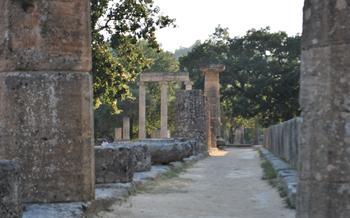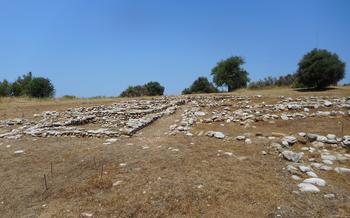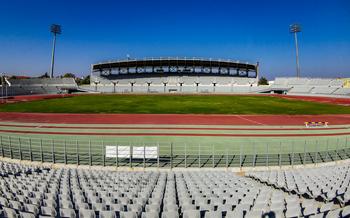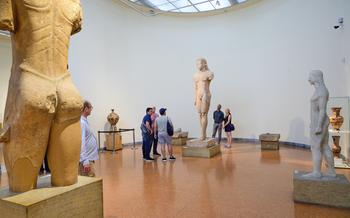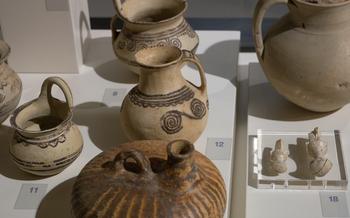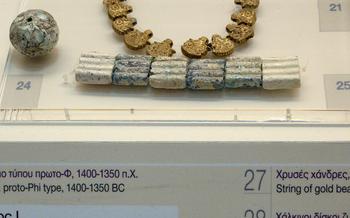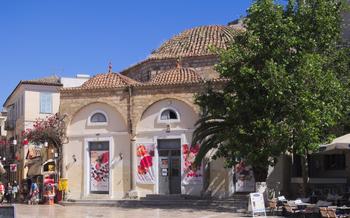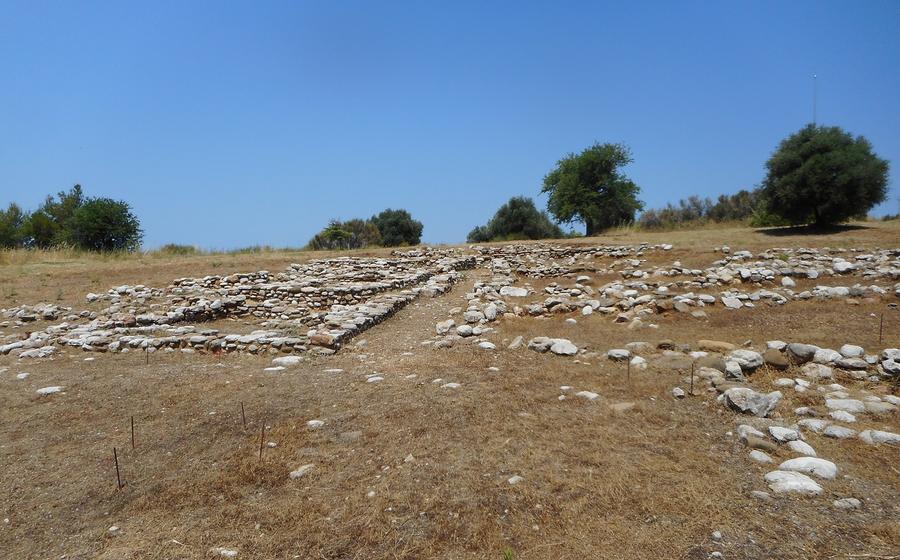
Patras Mycenaean Park
- The Antiquity of Patras
- The Patras Mycenaean Park
- Mycenaean Tombs
- The Tholos Tombs
- Mycenaean Pottery
- Jewelry and Artifacts
- The Role of the Dead
- The Mycenaean Civilization
- Interactive Displays
- Educational Programs
- Accessibility
- Surrounding Attractions
- Tips for Visitors
- Local Cuisine
- Insider Tip: Unveiling Hidden Treasures
The Antiquity of Patras
Patras, a city steeped in ancient history, boasts a rich tapestry of archaeological wonders that unveil the grandeur of its past. In the realm of antiquity, Patras holds a significant place, serving as a vital port city in ancient Greece. Its strategic location at the crossroads of major trade routes fueled its prosperity, attracting diverse cultures and influences. Archaeological excavations have unearthed an abundance of artifacts, shedding light on the city's vibrant past. Among the most captivating discoveries are the Mycenaean tombs, remnants of a civilization that left an indelible mark on the region's history.
The Patras Mycenaean Park
The Patras Mycenaean Park, located just a few kilometers from the city of Patras, in southern Greece, is a unique archaeological site that offers a fascinating glimpse into the Mycenaean civilization, which flourished in Greece during the Late Bronze Age (1600-1100 BC). The park was established in 2009 and encompasses an area of over 10 hectares, making it one of the largest Mycenaean sites in Greece.
The park features a number of impressive Mycenaean tombs, including two tholos tombs, which are circular structures with a domed roof. These tombs are believed to have been built for the elite members of Mycenaean society, and some of them contain elaborate grave goods, such as jewelry, pottery, and weapons. The park also features a number of other Mycenaean structures, such as a settlement and a workshop, which provide a glimpse into the daily life of the Mycenaeans.
The Patras Mycenaean Park is a must-see for anyone interested in ancient Greek history and culture. It is easily accessible by car or public transportation, and there is a small admission fee. The park is open to visitors year-round, but it is best to visit during the spring or fall when the weather is mild.
Mycenaean Tombs
The Mycenaean tombs are the most prominent and well-preserved structures in the Patras Mycenaean Park. These tombs offer a glimpse into the burial practices and customs of the Mycenaeans, an ancient civilization that flourished in Greece from around 1600 to 1100 BC. The tombs are impressive examples of Mycenaean engineering and architecture, showcasing their advanced skills in construction and design.
The tombs are typically circular in shape and built using large stone blocks, a technique known as cyclopean masonry. They are divided into two main types: chamber tombs and tholos tombs. Chamber tombs are smaller and simpler in design, consisting of a single chamber with a dromos, or entrance passage. Tholos tombs are larger and more elaborate, featuring a circular chamber with a corbelled roof that gradually curves inward to form a dome.
The tombs were used for multiple burials, with the remains of several individuals interred within each tomb. The bodies were placed in stone-lined cists, or graves, and accompanied by a variety of grave goods, such as jewelry, pottery, weapons, and tools. These offerings were believed to aid the deceased in the afterlife.
The Tholos Tombs
The tholos tombs are a distinctive feature of the Patras Mycenaean Park, setting it apart from other Mycenaean sites in Greece. These monumental tombs, characterized by their circular or beehive-shaped structures, are a testament to the architectural prowess and cultural significance of the Mycenaean civilization.
Among the several tholos tombs in the park, one stands out as the largest and most impressive. Known as Tholos Tomb 5, it boasts a remarkable diameter of over 14 meters and a height of approximately 13 meters. The imposing size of this tomb reflects the importance of the individual buried within and the prestige associated with tholos tombs.
The architectural elements of the tholos tombs are noteworthy. Constructed using the corbelled arch technique, they feature a series of concentric rings of stone that gradually converge towards the top, creating a self-supporting dome. This innovative construction method allowed the Mycenaeans to create vast and stable burial chambers without the use of columns or beams.
The design of the tholos tombs is equally intriguing. The entrance to each tomb is marked by a monumental doorway, often flanked by impressive stone jambs and a relieving triangle above the lintel. Inside, the tombs feature a circular chamber with a raised platform or kline in the center, where the deceased was laid to rest. Niches and recesses in the walls provided spaces for offerings and grave goods.
The presence of tholos tombs in the Patras Mycenaean Park offers visitors a glimpse into the elaborate burial practices and social stratification of the Mycenaean civilization. These impressive structures continue to captivate and inspire, providing valuable insights into the lives and beliefs of this ancient society.
Mycenaean Pottery
Pottery played a vital role in Mycenaean culture, serving various purposes beyond mere functionality. It symbolized status, wealth, and artistry. Mycenaean pottery is renowned for its distinctive features, such as its lustrous finish, vibrant colors, and intricate decorative motifs. These motifs often depicted scenes from mythology, nature, and everyday life, providing valuable insights into the Mycenaean worldview. The park showcases an impressive collection of pottery, including vases, bowls, cups, and storage jars. Each piece is a testament to the skill and creativity of Mycenaean artisans. Visitors can admire the intricate details and vibrant hues that have remained remarkably preserved over the centuries.
Jewelry and Artifacts
Excavations at the Patras Mycenaean Park have revealed an array of exquisite jewelry and artifacts that provide valuable insights into the artistic prowess and cultural practices of the Mycenaeans. Among the most notable discoveries are intricately crafted gold and silver ornaments, adorned with semi-precious stones such as amethyst, carnelian, and lapis lazuli. These adornments include necklaces, earrings, bracelets, rings, and pendants, showcasing the Mycenaeans' mastery of metallurgy and their appreciation for personal adornment. In addition to jewelry, the park has yielded a wealth of other artifacts, including bronze weapons, pottery vessels, tools, and seals. These objects offer a glimpse into the daily lives and activities of the Mycenaeans, shedding light on their technological achievements, economic pursuits, and artistic sensibilities.
The Role of the Dead
The Mycenaeans held elaborate beliefs about the afterlife, which influenced their burial practices and customs. They believed that the dead continued to exist in a realm known as the "Underworld" or "House of Hades." According to their mythology, the entrance to the Underworld was guarded by the three-headed dog Cerberus.
To ensure a safe and comfortable journey for the deceased, the Mycenaeans placed various grave goods and offerings in the tombs. These offerings included personal belongings, such as jewelry, pottery, and weapons, as well as food and drink to sustain the deceased in the afterlife.
The Mycenaeans also believed in a strong connection between the living and the dead. They often visited the tombs of their ancestors to pay their respects and seek their guidance. These visits were accompanied by rituals and offerings, demonstrating the enduring bond between the two realms.
The Mycenaean Civilization
The Mycenaean civilization, which flourished in mainland Greece from around 1600 to 1100 BC, was one of the most advanced and influential civilizations of the Bronze Age. The Mycenaeans were a warrior society, and their culture was characterized by its militaristic nature and its emphasis on material wealth. They were also skilled builders and engineers, and their impressive fortifications and palaces are still standing today.
The Mycenaeans were also accomplished traders, and their influence extended throughout the Mediterranean. They established trading colonies in Italy, Sicily, and the Near East, and their goods were found as far away as Egypt and Mesopotamia. The Mycenaean civilization eventually collapsed around 1100 BC, but its legacy lived on in the culture of the Classical Greeks. The Mycenaeans' achievements in art, architecture, and warfare would have a profound impact on the development of Western civilization.
Interactive Displays
The Patras Mycenaean Park embraces technology to enhance the visitor experience and make history come alive. Interactive exhibits and multimedia presentations are strategically placed throughout the park, providing an immersive and educational journey into the Mycenaean civilization.
Touchscreens allow visitors to explore detailed maps of the site, learn about the significance of specific artifacts, and delve into the daily lives of the Mycenaeans. Virtual reality (VR) experiences transport visitors back in time, offering a firsthand glimpse into the grandeur of the tholos tombs and the bustling streets of the ancient city.
Augmented reality (AR) technology overlays digital content onto the physical environment, bringing the Mycenaean world to life before your eyes. Through AR apps, visitors can interact with 3D models of artifacts, witness reenactments of Mycenaean rituals, and even engage in virtual excavations.
These interactive displays not only enhance the visitor experience but also cater to different learning styles and interests. They transform the park into a dynamic and engaging space where history unfolds in a captivating and memorable way.
Educational Programs
The Patras Mycenaean Park is more than just a collection of ancient ruins; it is also a vibrant center for education and cultural exploration. The park's extensive educational programs are designed to bring the Mycenaean civilization to life for visitors of all ages, fostering a deeper understanding and appreciation for this significant period in Greek history.
For school groups and organized tours, the park offers guided tours led by expert archaeologists and historians who provide in-depth insights into the Mycenaean culture, architecture, and burial practices. These tours are tailored to different age groups and educational levels, ensuring that students have a meaningful and engaging learning experience.
In addition to guided tours, the park hosts interactive workshops and hands-on activities that allow visitors to get a firsthand feel for the Mycenaean way of life. These workshops cover topics such as pottery making, jewelry design, and ancient writing systems, providing a unique and immersive way to connect with the past.
The park's educational programs are not limited to school groups. Adult visitors can also participate in lectures, seminars, and cultural events that delve into the latest archaeological discoveries and research on the Mycenaean civilization. These events offer a platform for knowledge exchange and foster a sense of community among history enthusiasts.
By promoting cultural heritage and providing educational opportunities, the Patras Mycenaean Park plays a crucial role in preserving the legacy of the Mycenaeans and inspiring future generations to explore the wonders of the ancient world.
Accessibility
The Patras Mycenaean Park recognizes the importance of inclusivity and strives to provide a welcoming and accessible environment for all visitors. Several facilities and services have been implemented to ensure that individuals with disabilities can fully enjoy and appreciate the park's offerings.
Wheelchair users and visitors with limited mobility can navigate the park's paths and exhibits with ease, thanks to well-maintained ramps and accessible pathways. Accessible restrooms are conveniently located throughout the park, providing a comfortable and hassle-free experience for all.
In addition, the park's staff is trained to assist visitors with disabilities, offering guidance and assistance as needed. They can provide information about accessible routes, parking options, and any other specific requirements visitors may have.
The Patras Mycenaean Park is committed to creating an inclusive environment where everyone can engage with and learn from the wonders of ancient Mycenaean culture. By prioritizing accessibility, the park ensures that all visitors can have a fulfilling and enriching experience.
Surrounding Attractions
Beyond the captivating allure of the Patras Mycenaean Park, the city of Patras and its surrounding areas offer a wealth of additional attractions that beckon travelers to explore further.
The Archaeological Museum of Patras is a treasure trove of ancient artifacts unearthed from the region, providing an immersive journey through the rich history of Patras and its environs. From exquisite sculptures and pottery to intriguing inscriptions, the museum houses a diverse collection that sheds light on the city's past.
A short drive from Patras, the awe-inspiring Rio-Antirrio Bridge stands as a testament to modern engineering prowess. This architectural marvel spans the Gulf of Corinth, connecting the Peloponnese peninsula with mainland Greece. Visitors can marvel at the bridge's graceful form while enjoying breathtaking views of the surrounding landscape.
Venturing into the Peloponnese, travelers are greeted by a tapestry of ancient ruins, picturesque villages, and stunning natural landscapes. From the ancient city of Olympia, birthplace of the Olympic Games, to the medieval hilltop town of Mystras, the Peloponnese offers a captivating blend of history, culture, and natural beauty.
Whether seeking to delve deeper into the region's archaeological heritage, marvel at architectural wonders, or simply revel in the beauty of the Greek countryside, the surroundings of Patras offer a multitude of experiences that complement a visit to the Mycenaean Park perfectly.
Tips for Visitors
When planning your visit to the Patras Mycenaean Park, consider the following tips to make the most of your experience:
-
Best Time to Visit: Aim for spring or autumn (April-May or September-October) to avoid the summer heat and crowds. The park's serene atmosphere is best enjoyed in the mild shoulder seasons.
-
Dress Code: Respect the historical significance of the site by dressing modestly. Avoid revealing clothing and opt for comfortable, lightweight attire suitable for walking on uneven ground.
-
Photography Guidelines: While photography is allowed in the park, flash photography is prohibited to preserve the integrity of the artifacts. Be mindful of other visitors and avoid obstructing their views or taking intrusive photographs.
Local Cuisine
As you explore the historical wonders of the Patras Mycenaean Park, don't miss the opportunity to indulge in the delicious flavors of traditional Greek cuisine. Patras offers a vibrant culinary scene with an array of restaurants and tavernas that showcase the region's culinary heritage.
For an authentic Greek experience, start your meal with a selection of fresh seafood dishes, such as grilled octopus, succulent shrimp, or tender calamari. These dishes are often prepared with simple yet flavorful ingredients, allowing the natural taste of the sea to shine through.
If you prefer meat-based dishes, try the slow-cooked lamb or beef stews, which are infused with rich spices and herbs. These hearty meals are often accompanied by rustic bread, perfect for soaking up the delicious sauces.
For a lighter option, sample the variety of fresh salads and vegetable dishes. The Greek salad, with its combination of tomatoes, cucumbers, onions, and feta cheese, is a must-try. Other popular choices include grilled vegetables, stuffed vine leaves, and zucchini fritters.
No Greek meal is complete without a taste of the local wines. The Peloponnese region is renowned for its vineyards, producing a range of red, white, and rosé wines. Ask your server for recommendations to pair with your meal and enhance your dining experience.
Whether you choose to dine in a traditional taverna or a modern restaurant, Patras offers a culinary journey that complements the historical exploration of the Mycenaean Park. Indulge in the flavors and aromas of Greek cuisine and create lasting memories that will tantalize your taste buds long after your visit.
Insider Tip: Unveiling Hidden Treasures
Beyond the well-trodden paths of the Patras Mycenaean Park, there lie hidden gems waiting to be discovered. Venture off the main trails and explore the lesser-known corners of the park to uncover secluded tombs and breathtaking views. One such spot is the hidden tholos tomb, nestled amidst a grove of ancient olive trees. Its well-preserved interior and intricate carvings offer a glimpse into the artistry and craftsmanship of the Mycenaean civilization. For those seeking a unique photographic opportunity, climb to the top of the hill overlooking the park. From this vantage point, you'll capture panoramic views of the surrounding landscape, with the sparkling Gulf of Patras in the distance. Remember to bring your camera and an adventurous spirit to fully immerse yourself in the secrets of the Patras Mycenaean Park.
